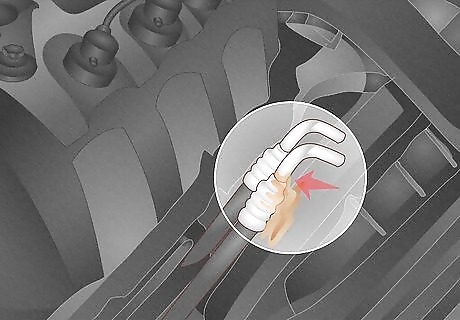
views
Your air conditioner is low on refrigerant or has a leak.

Refrigerant is a special liquid that helps the A/C cool down air. Normally, your A/C pumps the refrigerant through a series of pipes, called an evaporator. As a fan blows air over the evaporator, the heat from the air is transferred to the refrigerant, cooling the air down before it’s blown into the car. If the refrigerant levels get too low, this process fails and the air stays warm. This sometimes occurs due to leaks. Symptoms: Your car’s check engine light may come on if the refrigerant level gets too low. Note that refrigerant leaks are difficult to spot because the liquid evaporates rapidly. It doesn’t pool or leave spots, like oil does. Fixes: Have a mechanic inspect your air conditioning system for leaks. They can make repairs and add refrigerant to replace what was lost. If there is no leak, add refrigerant to your car’s A/C system or ask a mechanic to do so.
The thermostat is broken, or you’re using the wrong setting.

Your thermostat tells the A/C how cold the air should be. In most cars, you must select “A/C” to turn the air conditioner on—otherwise, the fans will still blow, but the air won’t cool down. If the thermostat is broken, however, the air conditioner may not turn on at all, and the fans will always blow warm air. Fixes: Check your car’s thermostat carefully. Make sure “A/C” is selected, then choose a temperature that’s lower than the ambient temperature outside. If “A/C” is definitely selected and the temperature is set to low, but your fans still blow warm air, your thermostat might be broken. Have a mechanic check your thermostat and repair it.
The A/C’s condenser is blocked or malfunctioning.

A condenser dissipates heat so the A/C can do its job. The condenser is a rectangular sheet of metal tubes, similar to a radiator, that sits in front of your car’s engine. If the condenser breaks or its tubes get blocked, the refrigerant flowing in the tubes can’t cool down. Without cooled refrigerant, the A/C can’t cool the air blowing into your car. Symptoms: The condenser fan may run continuously, but the A/C still blows warm air. The condenser fan is located in front of the condenser just behind your car’s front grill. It should only run intermittently, unless the weather is extremely hot. Fixes: Ask a mechanic to inspect and repair any leaks or blockages. If it can’t be repaired, they’ll replace the condenser completely.
Your car’s air filter is dirty.

The filter keeps the air in your car free of dirt and debris. Over time, your filter can get clogged, blocking airflow and preventing your A/C from cooling the car. A dirty filter may also contain dirt, germs, pollen, and mold spores—things that can make you sick or uncomfortable. Symptoms: In addition to blowing warm air, your A/C may smell dirty or moldy. The air may blow more softly than it used to since it’s partially blocked by the dirty filter. Fixes: Check the air filter and replace it if it’s dirty, or have a mechanic do it for you.
The A/C’s compressor is broken.

A compressor helps the A/C regulate air temperature. It acts like a “heart” pumping refrigerant through the A/C’s pipes, cooling the air that enters your car while releasing hot air into the environment outside. If the compressor breaks, the refrigerant can’t move through the system, and the air can’t be cooled down. Symptoms: You may hear loud clattering noises after turning on your A/C. This could indicate that parts of the compressor are broken. The compressor may stop immediately after starting up. This sometimes occurs when the compressor’s clutch may seize up or stop working. The clutch allows the compressor to draw power from the engine. Without a working clutch, the compressor can’t run continuously. Fixes: Have a mechanic diagnose the problem. If necessary, they’ll replace the compressor or fix malfunctioning components.
Your car’s electrical system might be malfunctioning.

The electrical system provides power for the A/C’s components. Blown fuses, frayed wires, and short circuits can prevent power from reaching those components. For instance, a blown fuse could cause the compressor to stop working, preventing the air from getting cooled down as it blows into your car. Symptoms: Your car’s dashboard may display warning lights indicating electrical problems. For example, the battery warning light may come on. Fixes: Ask a mechanic to check your car’s fuse box, wiring, and other electrical components. Have them replace any blown fuses or make other electrical repairs. For your safety, avoid tinkering with your car’s electrical system.




















Comments
0 comment